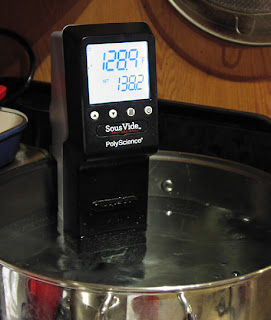 |
| Polyscience Sous Vide Immersion Circulator |
 |
| Caso Vacuum Sealer |
Can't Live Without:
Chef's Knife. If you can only have one knife, this is the one to have. And size does matter. To really be a workhorse in the kitchen, it has to be at least an 8" or 10" knife. For 10" knives, I like a wider blade, with enough curvature to rock back and forth comfortably. Below I list the ones I use, but I still think it is important to go to the store see which ones feel most comfortable to you.
Forchner Fibrox Series: I use this knife at work. It's a great value at under$30 and really takes a beating. It's dishwasher safe and keeps a great edge. I only need to sharpen it once a week, and sometimes can go two weeks.
Wusthof Grand Prix : This is the knife I use most at home. It's lighter in weight than comparable knives by J. Henckels and keeps a great edge. I don't like the new handle style on the more recent Grand Prix II Series though.
Kikiuchi Carbon Steel: A lot of chefs now prefer Japanese knives with a traditional carbon steel blade. This knife was a splurge - a little graduation gift I got myself after culinary school. Initially I babied this knife, and didn't use it that regularly, because it isn't rust proof and must be hand-washed and dried. When I got kind of lazy and let my Forchner go dull, I brought the Kikiuchi to work with me. What a difference. The blade is thin and lightweight blade and it only takes a few passes on a fine stone or steel to keep it razor sharp. There are many more popular Japanese knife makers such as Misono, Mac, and Shun, making less expensive western style knives that seem worth checking out too.
Paring Knife. It's the second most useful knife in the kitchen, but I don't see the point in spending a lot on a paring knife. At work I use a L'Econome, made by Inox France. They are really inexpensive ($7.95), with a simple wooden handle that comes in several colors (I have a red and a green one). The blade is light and very sharp and cuts cleanly and accurately. At home I also have a Wusthof Grand Prix paring knife that I like a lot too, but if it hadn't come as part of a set, I probably wouldn't have bothered.Sharpening Steel. Essential for keeping your blades honed, between stone-sharpening sessions. I use a traditional steel, and a diamond steel. The traditional steel simply re-aligns the blade, but the diamond steel takes off a bit of the blade, slightly sharpening it as well. Both are by Wusthof.
Kitchen Tongs. Think of them as an extension of your hands. I use them for everything from flipping steaks and chops, fishing items out of a simmering pot or fryer or stacking said items on a plate. As for what kind to get, the ones made by Edlund are my favorite. I have the traditional scallop-head ones in 12" length for all around use, and 16" length for grilling and barbeque. 9" tongs are good to have for smaller jobs too. Edlund also make tongs with a locking mechanism (nice for storage) that actually stays in position. There is nothing more annoying than flimsy tongs with a locking mechanism that's so loose they lock closed when you go to pick something up. By the way, some cooks favor using chopsticks instead of tongs because they feel that tongs cut into and damage the food, but unless you can wield a pair of chopsticks like Mr. Miagi, I recommend the tongs.
Stainless Steel Saute Pan. 10" is just the right size for cooking at home for two, but for a family of four, get a 12" pan. Make sure you have a pan that has some weight to it. Flimsy saute pans won't heat evenly and you'll get scorching or hot spots. Say what you want about All Clad being expensive, but boy is it worth it. Their handles stay cool (how do they do that?) and the pan heats up nice and evenly. I have one pan that is an All Clad Stainless, and another that is the less expensive All Clad MC2. Both perform very well.
Carbon Steel Fry Pans
Food Processor. Get the big one, you know, the 14-cup one? I have a KitchenAid KPF750 which I use for everything from pie dough, to hummos to making butter. I use the slicing blade to make coleslaw, and the shredding blade for large quantities of cheese or carrots. This one comes with a smaller work bowl that fits inside the larger one, for smaller jobs too.
Nice but not essential:
Stand Mixer. When I bake, I still mix a lot of stuff by hand, so I don't consider a stand mixer totally essential. Still, it is nice to use for making yeast doughs that need a lot of kneading, which is why I wouldn't bother with anything less than a heavy duty model like the Kitchen Aid Artisan. The Kitchen Aid Commercial Series is even more powerful, but also more expensive. One of the perks of the Kitchen Aid stand mixers that I like, however, are the attachments you can buy to grind your own meat, or roll your own pasta, or even mill your own grain!

